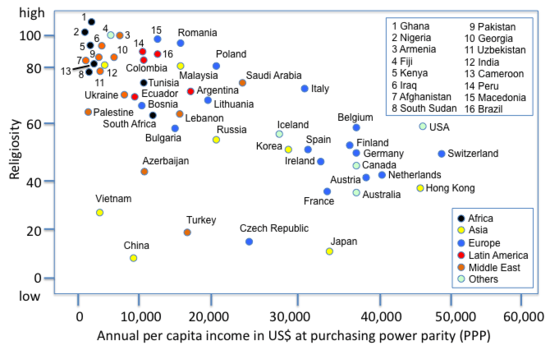Wealth and religion

The correlation between wealth and religion has been subject to academic research. Wealth is the status of being the beneficiary or proprietor of a large accumulation of capital and economic power. Religion is a cultural system that often involves belief in supernatural forces and may intend to provide a moral system or a meaning of life.
The GDP of countries generally correlates negatively with their religiosity, i.e. the wealthier a population is the more secular it is.[2]
Statistics
Global
According to a study from 2015, Christians hold the largest amount of wealth (55% of the total world wealth), followed by Muslims (5.8%), Hindus (3.3%) and Jewish (1.1%). According to the same study it was found that adherents under the classification Irreligion or other religions hold about 34.8% of the total global wealth.[3]
United States

A study in the United States (based on data from 1985-1998), conducted by sociologist Lisa A. Keister and published in the Social Forces journal, found that adherents of Judaism and Episcopalianism[4] accumulated the most wealth, believers in Catholicism and mainline Protestants were in the middle, while conservative Protestants accumulated the least; in general, people who attend religious services accumulated more wealth than those who do not (taking into account variations of education and other factors).[5] Keister suggested that wealth accumulation is shaped by family processes.[6]
In the United States, 48% of Hindus have a household income of $100,000 or more, and 70% make at least $75,000, which is the highest among all religions in United States. [7] The median net worth of people believing in Judaism is calculated at 150,890 USD, while the median net worth of conservative Protestants (including Baptists, Jehovah's Witnesses, Seventh-day Adventists, Christian Scientists) was 26,200 USD. The overall median in the dataset was 48,200 USD.[5]
A study done by the nonpartisan wealth research firm New World Wealth found that 56.2% of the 13.1 million millionaires in the world were Christians,[8] while 6.5% were Muslims, 3.9% were Hindu, and 1.7% were Jewish; 31.7% were identified as adherents of "other" religions or "not religious".
Explanations
A study published in the American Journal of Sociology by Lisa Keister, found that "religion affects wealth indirectly through educational attainment, fertility, and female labor force participation" but also found some evidence of direct effects of religion on wealth attainment.[9] Keister notes that certain religious beliefs ("one should have many children", "women should not work") lower wealth accumulation, both on the micro- and macro-scale.[9][10]
See also
- Christian views on poverty and wealth
- Economics of religion
- Happiness and religion
- Jewish views of poverty, wealth and charity
- The Protestant Ethic and the Spirit of Capitalism
- Religion and peacebuilding
- Religion and business
- Religion and Poverty
- Religiosity and intelligence
- Female labor force in the Muslim world
Books:
References
- ↑ WIN-Gallup. "Global Index of religion and atheism." (PDF). Retrieved 21 October 2012.
- ↑ Survey Reports. "World Publics Welcome Global Trade — But Not Immigration | Pew Global Attitudes Project". Pewglobal.org. Retrieved 2011-10-21.
- ↑ "Christians hold largest percentage of global wealth: Report". deccanherald.com. 2015-01-14.
- ↑ Irving Lewis Allen, "WASP—From Sociological Concept to Epithet," Ethnicity, 1975 154+
- 1 2 "Religion Helps Shape Wealth Of Americans, Study Finds". Researchnews.osu.edu. Retrieved 2011-10-21.
- ↑ "Religion and wealth: The role of religious affiliation and participation in early adult asset accumulation = Religion et richesse: le rôle de l'affiliation et de la participation religieuse dans l'accumulation de biens à l'entrée de la vie adulte". Cat.inist.fr. Retrieved 2011-10-21.
- ↑ "Hindu-Americans Rank Top in Education, Income". Retrieved Dec 1, 2012.
- ↑ The religion of millionaires
- 1 2 Keister, Lisa A. (March 2008). "Conservative Protestants and Wealth: How Religion Perpetuates Asset Poverty". American Journal of Sociology. 113 (5): 1237–1271. doi:10.1086/525506.
- ↑ "How Religion Contributes To Wealth And Poverty". The Huffington Post.
External links
- Does God Want You To Be Rich?, Time Magazine